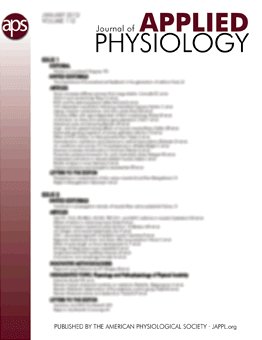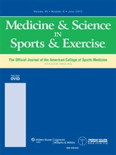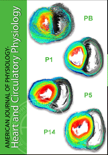
Journal of Applied Physiology
Scope & Guideline
Advancing the Frontiers of Physiology and Health.
Introduction
Aims and Scopes
- Exercise Physiology and Performance:
Research on the physiological adaptations to different forms of exercise, including strength, endurance, and high-intensity interval training. This includes studies on metabolic responses, muscle function, and cardiovascular adaptations. - Health and Disease Management:
Investigations into how exercise influences health markers and disease outcomes. This encompasses studies on chronic conditions such as diabetes, hypertension, and obesity, and how physical activity can mitigate health risks. - Neuromuscular Function and Fatigue:
Exploration of the neural and muscular mechanisms underlying fatigue and performance, including studies on motor unit recruitment, muscle action potentials, and recovery strategies. - Thermoregulation and Environmental Physiology:
Research on how environmental factors (e.g., heat, altitude) affect physiological responses during exercise, including adaptations to heat acclimatization and the impact of hypoxia. - Nutritional Interventions and Performance:
Studies on the effects of dietary supplements, hydration strategies, and nutritional timing on exercise performance and recovery, including the role of macronutrients and micronutrients. - Age and Sex Differences in Physiology:
Research examining how aging and sex influence physiological responses to exercise, including differences in muscle function, cardiovascular adaptations, and recovery patterns.
Trending and Emerging
- High-Intensity Interval Training (HIIT):
There is a marked increase in research on HIIT, demonstrating its effectiveness in improving cardiovascular fitness and metabolic health. Studies are exploring the physiological mechanisms behind HIIT adaptations and its application in various populations. - Psychophysiological Responses to Exercise:
An emerging trend is the investigation of how psychological factors, such as perceived exertion and mental fatigue, interact with physiological responses during exercise, highlighting the importance of the mind-body connection. - Wearable Technology and Remote Monitoring:
The integration of wearable technology in exercise physiology research is on the rise, with studies assessing its impact on monitoring training loads, recovery, and real-time physiological responses. - Nutritional Strategies for Performance Enhancement:
Research on the role of nutrition, including supplementation and dietary strategies, in enhancing exercise performance and recovery is becoming more prominent, reflecting a holistic approach to training. - Climate and Environmental Physiology:
There is an increasing focus on how environmental factors, such as heat and altitude, affect exercise performance and recovery, with implications for training and competition strategies. - Muscle and Neuromuscular Function in Aging:
Emerging studies are delving into the physiological adaptations of older adults to exercise, emphasizing the importance of maintaining muscle function and preventing frailty through targeted interventions.
Declining or Waning
- Traditional Endurance Training Studies:
There seems to be a decline in studies focusing solely on traditional endurance training protocols, as newer methodologies such as high-intensity interval training (HIIT) gain more attention for their efficiency and effectiveness. - Basic Biochemical Mechanisms:
Research that solely focuses on basic biochemical mechanisms without a clear application to exercise performance or health outcomes appears to be waning. The journal is increasingly favoring studies that translate basic science into practical applications. - Static Stretching Effects:
The exploration of static stretching on performance outcomes is decreasing, possibly due to the growing consensus that dynamic warm-ups and more functional movement patterns are more beneficial for performance. - Overly Specialized Population Studies:
There seems to be a reduction in studies that focus exclusively on very niche populations, such as elite athletes in specific sports, as the journal increasingly emphasizes broader applicability and relevance to general populations.
Similar Journals

Current Opinion in Physiology
Illuminating Emerging Trends in Physiological ScienceCurrent Opinion in Physiology, published by Elsevier, is a leading journal dedicated to the dynamic field of physiology. With an E-ISSN of 2468-8673, this journal provides a platform for the latest insights and perspectives, reflecting the evolving landscape of physiological research. Operating from the United Kingdom, the journal holds a respectable impact factor and is ranked Q2 in both general physiology and medical physiology categories, highlighting its prominence among the global academic community. With Scopus rankings placing it in the 64th and 60th percentiles within its respective categories, Current Opinion in Physiology serves as an essential resource for researchers, professionals, and students eager to stay informed about innovative theories and emerging trends in physiology. The publication emphasizes high-quality reviews that summarize current knowledge and future directions, ensuring readers gain valuable insights applicable in both clinical and research settings.

MEDICINE & SCIENCE IN SPORTS & EXERCISE
Elevating athletic health with cutting-edge insights.MEDICINE & SCIENCE IN SPORTS & EXERCISE is a premier journal published by Lippincott Williams & Wilkins, dedicated to advancing the fields of sports medicine, exercise physiology, orthopedics, and physical therapy. With a significant history dating back to 1969, this journal provides a critical platform for disseminating cutting-edge research and clinical insights that shape contemporary sports science. Recognized for its rigorous peer-review standards, it boasts an impressive impact factor and ranks in the top quartile (Q1) across pivotal categories including Orthopedics and Sports Medicine, Physical Therapy, and Rehabilitation. Researchers and healthcare professionals will find it an invaluable resource for the latest findings and trends that inform practice and enhance athletic performance. The journal is available in both print and digital formats, ensuring accessibility for its audience worldwide. By fostering a rich dialogue among scientists, practitioners, and students, MEDICINE & SCIENCE IN SPORTS & EXERCISE solidifies its importance in the evolving landscape of sports health and exercise research.

Journal of Exercise Science & Fitness
Advancing knowledge in exercise science and fitness.Journal of Exercise Science & Fitness is a premier Open Access journal published by Elsevier Singapore Pte Ltd, dedicated to advancing the field of exercise science through rigorous research and comprehensive reviews. Since its inception in 2005, the journal has made significant contributions to various domains including Pharmaceutical Science, Physical Therapy, and Sports Science, achieving a distinguished Q1 ranking in its respective categories as of 2023. With a commitment to disseminating knowledge without barriers, it has embraced an Open Access model since 2009, ensuring that cutting-edge findings are accessible to all researchers, practitioners, and students worldwide. Its high visibility is reflected in its Scopus rankings, placing it among the top-tier journals in the health professions and public health sectors. This journal serves as a critical platform for the latest developments in exercise science, promoting evidence-based practices that can enhance health and performance, making it an invaluable resource for those at the forefront of this dynamic field.

JOURNAL OF PHYSIOLOGY AND BIOCHEMISTRY
Empowering Scholars to Shape the Future of Health SciencesJOURNAL OF PHYSIOLOGY AND BIOCHEMISTRY, published by Springer in the Netherlands, serves as a pivotal platform for disseminating high-quality research within the fields of physiology, biochemistry, and related biomedical sciences. With an impressive impact factor reflected in its categorization as Q2 in Biochemistry and Q1 in Medicine (miscellaneous), this journal fosters a vibrant community of scholars dedicated to advancing knowledge and innovation. The journal’s broad scope encompasses a wide range of topics from cellular mechanisms to systemic physiology, making it relevant for both theoretical and applied sciences. Researchers and practitioners are encouraged to utilize the available Open Access options to reach a wider audience. The journal’s continuous contribution to the scientific dialogue since its inception in 1996 positions it as a key resource for professionals and students alike, facilitating the exploration of cutting-edge topics and collaborative research opportunities.

INTERNATIONAL JOURNAL OF SPORT NUTRITION AND EXERCISE METABOLISM
Advancing Athletic Excellence with Evidence-Based InsightsINTERNATIONAL JOURNAL OF SPORT NUTRITION AND EXERCISE METABOLISM, published by Human Kinetics, is a leading academic journal dedicated to the interdisciplinary fields of sports nutrition and exercise metabolism. With ISSN 1526-484X and E-ISSN 1543-2742, the journal provides a critical platform for researchers and practitioners to explore the intricate relationships between nutritional strategies, exercise physiology, and performance outcomes. Boasting a commendable impact factor and ranking in the Q2 category across multiple disciplines, including Medicine (miscellaneous), Nutrition and Dietetics, Orthopedics and Sports Medicine, and Sports Science, the journal is recognized for its contribution to advancing knowledge in these vital areas. Researchers are encouraged to submit their findings and engage with cutting-edge studies spanning from 1996 to the present. While the journal currently does not offer open access, its reputation as a peer-reviewed resource ensures high-quality evidence for both academic study and practical application. For those invested in optimizing athletic performance through nutritional insights, INTERNATIONAL JOURNAL OF SPORT NUTRITION AND EXERCISE METABOLISM is an invaluable resource.

Frontiers in Physiology
Exploring groundbreaking discoveries in physiology.Frontiers in Physiology, published by FRONTIERS MEDIA SA, is a leading open-access journal that has been at the forefront of physiological research since its inception in 2010. As a reputable publication based in Switzerland, it aims to foster the dissemination of groundbreaking findings across various domains of physiology, engaging a global audience of scholars and practitioners. With a commendable Q2 ranking in the fields of both general physiology and medical physiology for 2023, this journal stands out in its field, achieving a significant Scopus rank of #32/113 in medical physiology and #58/193 in biochemistry, genetics, and molecular biology. Frontiers in Physiology not only commits to maintaining high scholarly standards but also ensures that all its articles are freely accessible, thereby promoting collaborative knowledge exchange. With a clear focus on advancing our understanding of physiological processes, the journal plays a crucial role in the development of innovative approaches to health and disease, making it an essential resource for researchers, professionals, and students alike.

Physiological Genomics
Innovating the Understanding of Physiological MechanismsPhysiological Genomics is a prestigious scholarly journal published by the American Physiological Society, dedicated to advancing the understanding of the genetic underpinnings in physiology. With an ISSN of 1094-8341 and an E-ISSN of 1531-2267, this journal serves as a vital platform for researchers exploring the intersection of genetics and physiological processes. As of 2023, it enjoys a respectable impact factor, particularly standing strong in the Q2 quartile in both Genetics and Physiology categories, illustrating its importance within a competitive landscape. With an impressive rank of #69 out of 193 in Biochemistry, Genetics, and Molecular Biology - Physiology, and #128 out of 347 in Genetics, it reflects a robust commitment to quality research. Committed to fostering innovation, Physiological Genomics provides comprehensive access to groundbreaking studies from 1999 to 2024 and remains a quintessential resource for researchers, professionals, and students alike aiming to enhance their understanding of physiological genomics.

Journal of Physiological Sciences
Innovating Understanding in Physiological ResearchThe Journal of Physiological Sciences, published by BMC, stands as a prominent platform for the advancement of research in the field of physiology. Based in Japan, this open-access journal (ISSN: 1880-6546, E-ISSN: 1880-6562) is committed to disseminating high-quality scientific articles that explore various facets of physiological functions and mechanisms. With a 2023 Scopus ranking placing it within the 41st percentile in the category of Physiology, it is recognized for contributing significant insights that bridge basic and applied physiological research. The journal maintains a Q2 quartile ranking within its category, highlighting its impact within the scientific community. Researchers, professionals, and students are encouraged to engage with cutting-edge studies published from 2006 to 2024, fostering an environment of knowledge accessibility and scientific collaboration. The journal not only serves as a vital resource for those involved in physiological research but also promotes broader understanding and application of physiological principles across various health and science sectors.

Physiological Reports
Igniting Curiosity in the Heart of PhysiologyPhysiological Reports is a pioneering open-access journal published by WILEY, dedicated to advancing the field of physiology through the dissemination of high-quality research. Since its inception in 2013, this journal has provided a platform for innovative studies in both general physiology and medical physiology, making significant contributions to our understanding of biological processes. With an impact factor that reflects its growing influence—as evidenced by its placement in the Q2 category for physiology and medical physiology in 2023—Physiological Reports is positioned as a vital resource for researchers and practitioners alike. The journal encourages the submission of diverse studies ranging from cellular mechanisms to systemic physiology, presenting a unique opportunity for authors to reach a global audience without access barriers. It has established a reputation for rigorous peer review and timely publication, ensuring that cutting-edge research is readily available to stimulate further inquiry and collaboration in the scientific community.

AMERICAN JOURNAL OF PHYSIOLOGY-HEART AND CIRCULATORY PHYSIOLOGY
Pioneering insights in cardiovascular science.AMERICAN JOURNAL OF PHYSIOLOGY-HEART AND CIRCULATORY PHYSIOLOGY, published by the American Physiological Society, is a premier journal dedicated to advancing the understanding of cardiovascular physiology. With an ISSN of 0363-6135 and an E-ISSN of 1522-1539, this esteemed journal has been a vital resource since its inception in 1977, and continues to publish cutting-edge research that shapes the fields of cardiology and physiology. Recognized as a Q1 journal in multiple categories, it ranks impressively within the top tier of its fields, including a notable 18th percentile rank in Physiology (medical). The journal’s impact factor and extensive reach in the academic community affirm its significance in promoting innovative studies and insights. While it does not offer open access options, the journal remains accessible through institutional subscriptions, making it an essential tool for researchers, professionals, and students alike, who are keen to stay abreast of the latest developments in heart and circulatory physiology. For further information, the journal is based in the United States at 6120 Executive Blvd, Suite 600, Rockville, MD 20852. As a cornerstone of cardiovascular research, it invites contributions that push the boundaries of knowledge and enhance clinical practice.